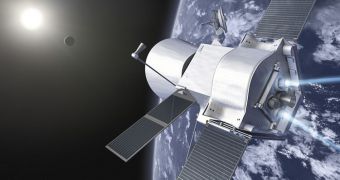The NASA Mercury Surface, Space Environment, Geochemistry and Ranging (MESSENGER) space probe will soon get a companion in orbit above the hellish nightmare that is the planet Mercury. The European Space Agency has signed the contract for securing a heavy-lift rocket to get it there.
In a ceremony that took place today, September 15, in Paris, ESA officials signed an agreement with representatives from European rocket manufacturer Arianespace. The document secures a renowned Ariane 5 heavy-lift delivery system for the BepiColombo mission
ESA Director General Jean-Jacques Dordain and Arianespace Chairman and CEO Yves Le Gall formalized the launch contract agreement officially today, after a long phase of planning and discussions. The mission is not targeted for launch in July 2014.
The vehicle will launch from the space agency's Kourou Spaceport, in French Guiana, South America. The facility is closer to the Equator than any other ESA installation, allowing for a multitude of possibilities as far as potential orbits go.
BepiColombo represents the first time Europeans show interest in the innermost planet. ESA already collaborated with NASA on several major undertakings such as the International Space Station, the Hubble Space Telescope and the Cassini orbiter, and has sent its own orbiters to Mars and Venus.
Now, it sets its sights on Mercury with this ambitious project, knowing fully well the amazingly-brutal conditions on and above the innermost planet in our solar system. Average temperatures on the surface of Mercury reach between 100 and 700 degrees Kelvin (minus 173 to 427 degrees Celsius).
“BepiColombo's sensors will completely map Mercury at different wavelengths, charting the planet's mineralogy and elemental composition. It will reveal the planet's interior structure and probe Mercury's magnetic field,” ESA says in a press release accompanying the announcement.
The Japan Aerospace Exploration Agency (JAXA) – which recently lost the Venus-bound Akatsuki orbiter to a thruster error – is cooperating with ESA on BepiColombo, as is the Russian Federal Space Agency (RosCosmos). The latter will contribute a gamma ray and neutron spectrometer.
After using solar-electric propulsion and gravity assist maneuvers to slingshot past the Moon, Earth and Venus, BepiColombo will eventually be grasped by Mercury's gravitational pull in 2020. At that time, it will begin its planned, 1-year mission to scan the planet.
After orbital insertion is achieved, the spacecraft will separate into its two main components, the ESA Mercury Planetary Orbiter and the JAXA Mercury Magnetospheric Orbiter.
“With BepiColombo, Europe continues to explore our Solar System. After Mars Express, Venus Express and the Huygens probe to Titan, we are now gearing up to explore a planet that is very close to the Sun, key to understanding the formation of our Solar System, and yet still very mysterious,” Dordain said at the signing ceremony.

 14 DAY TRIAL //
14 DAY TRIAL //